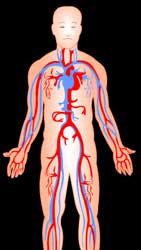The cardiovascular or circulatory
system is responsible for the movement of blood throughout the
body. It delivers oxygen, nutrients, and hormones to tissues and
organs and removes carbon dioxide and waste products. It consists of
a pump (the heart) and an extensive network of channels (arteries,
capillaries, and veins):
- Heart is a muscular organ
with three layers in its walls (endocardium, myocardium, and
epicardium), which rhythmically contracts to pump blood to the
pulmonary and systemic circulation
- Arteries carry blood away
from the heart and are classified as large or elastic, medium or
muscular, or small arteries
- Capillaries (microvascular
beds) allow for exchange of material between the blood and the
tissues
- Veins return the blood to
the heart and are classified as large, medium, or small veins
In addition to blood vessels, a
second network of channels, the lymphatic vessels, will also
be discussed in this module. These vessels carry lymph (interstitial
or tissue fluid), which is filtered through lymph nodes and
eventually returned back to the blood.
The learning objectives for this
session are:
- Identify the histological
characteristics of the heart, including the epicardium,
myocardium, and endocardium, and the conduction system.
- Identify and distinguish between
arteries, veins, capillaries, and lymph vessels (macrovasculature
versus microvasculature).
Let's first look at
the heart. |